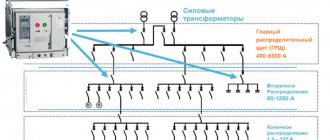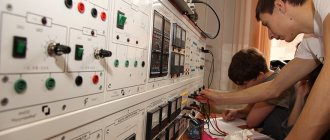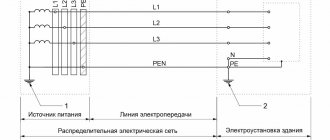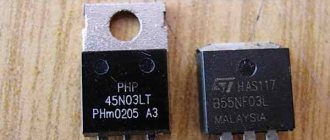Backup UPS (off-line, standby, back ups)
Operating principle
If the external network is operating in normal mode, the UPS powers the load directly from the input and operates similarly to a surge protector. In the event of a voltage deviation from acceptable limits or when it is completely turned off, the backup UPS automatically switches the load to the batteries (power in this mode is provided through an inverter that converts direct current into alternating current). Switching back is also automatic and occurs after the mains voltage returns to normal.
Advantages and disadvantages
Currently, the only significant advantages of off-line UPS include low cost.
The disadvantages of backup UPSs are:
- a break in the power supply that occurs when the load is switched to the battery and back (at least 5 ms);
- lack of voltage stabilization and frequency correction when operating from the mains;
- transition to AB even with small network surges, which, in the conditions of the domestic power system, leads to rapid wear of batteries;
- non-sinusoidal output voltage when operating in stand-alone mode (approximated sinusoid, sometimes called “quasi-sinusoid”);
- low level of protection against high-voltage surges and electromagnetic interference.
Application
The above disadvantages narrow the scope of application of backup UPSs. These devices are suitable for operation only in conditions of a stable electrical network and only with equipment capable of operating at low quality supply voltage. Off-line UPS should not be used to protect modern microprocessor technology or devices containing asynchronous and inverter motors - pumps, refrigerators, washing machines, air conditioners, heating boilers, etc.
Principle of operation
Conversion circuit
The standard operating mode of a line-interactive UPS is similar to the operation scheme of backup devices and provides for parallel connection directly from the network. The incoming AC voltage undergoes simple filtering. The built-in microprocessor records deviations, transmitting information to additional UPS components. Thus, electromagnetic interference and high-voltage pulses are eliminated by passive filters. Additionally, the input is equipped with a step voltage stabilizer or a universal regulator based on the operation of an autotransformer. They smooth out differences and provide adjustable output voltage.
Features of the device
The peculiarity of the operation of interactive UPSs is the ability to operate in two modes:
- As a voltage stabilizer. This mode is active as long as there is a voltage in the network that does not exceed the limits of the values to be stabilized (usually up to 20% of the nominal values).
- As a backup power source. In the event of sudden voltage fluctuations that go beyond the permissible values, or the occurrence of power outages, an automatic connection through the inverter to its own power sources (batteries) occurs. After troubleshooting, the load is switched back to mains power.
Important!
Depending on the construction scheme, voltage can be supplied by inverters in the form of either a “stepped” or a regular sinusoid. The first type of device is cheaper, it perfectly stabilizes the signal when powered from the network. In offline mode, it is not possible to obtain a pure sine wave. The second category is more expensive, but produces the correct sine wave regardless of the power source.
Line-interactive UPS
Operating principle
Similar to the previous option, except that the device circuit is supplemented with an input voltage regulator. UPS of this type are divided into devices with an approximate sinusoid and a completely sinusoidal output voltage.
Advantages and disadvantages
Advantages of line-interactive UPSs over backup ones:
- the ability to neutralize network fluctuations (but not the maximum amplitude!) without using AB;
- reduced switching time to offline mode (due to synchronization of the inverter and the input network).
The disadvantages of line-interactive UPSs are:
- stepwise voltage regulation, leading to severe distortion of the output signal;
- interruption in the power supply to the load when switching to batteries (switching duration is shorter than that of a backup UPS, but non-zero!);
- lack of correction of the shape of the input voltage and input frequency when operating from the mains, incomplete filtering of network noise;
- Most models do not form an ideal sine wave of the output voltage in stand-alone mode.
Application
Not all electrical equipment will work successfully with line-interactive UPSs. The quality of their output voltage may simply not meet the stringent requirements of modern electricity consumers in both the domestic and industrial sectors. In particular, a line-interactive UPS is not the best option for a heating system boiler, IT equipment, and especially for interference-sensitive scientific, laboratory and medical equipment.
In addition, line-interactive UPSs do not provide power that is completely independent of the state of the external power system, which maintains the risk of damage to the load as a result of, for example, a sudden mains interruption.
Batteries: an alternative to lead-acid batteries
Today, 95% of all uninterruptible power supplies are manufactured using lead-acid batteries as the DC power source.
Meanwhile, some vendors have already announced the start of converting several models of uninterruptible power supply devices from lead-acid batteries to lithium-ion ones. Their initial cost is still higher than lead-acid, but over the past few years the price gap has narrowed significantly.
According to Schneider Electric, depending on the application, lithium-ion batteries can achieve savings of 10-40% in total cost of ownership over their lifetime compared to traditional batteries.
Lithium-ion batteries (Li-ion) store much more energy in a smaller volume. Thus, compared to valve-regulated lead-acid (VRLA) batteries of equal power, they take up one-third the space. And thanks to their long service life, the amount of work and costs of replacing them are significantly reduced.
Meanwhile, the vast majority of UPSs are still equipped with lead-acid batteries, known for their reliability, high quality and optimal price characteristics.
Online UPS (on-line, double conversion UPS)
Operating principle
The device performs double conversion of the voltage coming from the network. First from variable to constant, and then back - from constant to variable. In the power circuit of an on-line UPS, the batteries occupy an intermediate position between the continuously operating rectifier and inverter (the batteries are connected to the output of the first and the input of the second). This scheme allows you to avoid delays when switching to offline mode, since the inverter is constantly connected to the battery and no additional switching is required in case of problems with the external power supply network.
Advantages and disadvantages
Advantages of online UPS:
- instant switching to battery power (without interruption of power supply to the load);
- sinusoidal shape and the most accurate value of the output voltage (provided both when operating from the mains and from batteries);
- wide amplitude of network fluctuations, neutralized without switching to offline mode;
- maximum load protection (double energy conversion dampens all negative input influences and guarantees complete independence of the UPS output characteristics from the state of the external power supply);
- no influence of connected equipment on the main power grid.
Disadvantages of online UPS:
- higher cost compared to devices of other categories;
- low efficiency (80-90%) of some outdated devices (it is worth noting that modern control algorithms for double energy conversion, used by leading manufacturers of on-line UPS, can significantly increase efficiency and bring it in a number of operating modes to 99%).
Three main types of UPS
Off-line (Back-UPS, backup, Standby) uninterruptible power supply
Example of a backup UPS: model APC Back UPS RS 650VA.
The operating principle of this type of uninterruptible power supply is very simple:
As long as there is electricity in the network within the set values, the UPS supplies the connected devices with voltage directly from the network, while simultaneously recharging the battery. The power passing through the UPS is not regulated; pulses and noise are filtered at the simplest level, using passive filters. The signal shape corresponds to the network signal, i.e., a sinusoid.
As soon as the mains power is lost, the UPS switches to battery power. The inverter that converts direct current from the battery into alternating current output is one of the simplest installed in this type of UPS, so the waveform does not correspond to the correct sine wave. The maximum that manufacturers do is to bring it somewhat closer to a sinusoid, making it stepwise.
The UPS also switches to off-line autonomous power supply if the voltage level in the network falls below or rises above the threshold values, they can be different depending on the brand of uninterruptible power supply.
The switching time to batteries in various models ranges from 5 to 20 ms. This is relatively long, and for some equipment models such a long delay may adversely affect operation. The long-term operation of the relay is due to the fact that the device needs the phases of the mains and battery voltages to coincide when the autonomous power is turned on, and since they are not synchronized, this takes some time.
Scheme of operation of a backup uninterruptible power supply.
Pros of Standby UPS:
- inexpensive price,
- high efficiency,
- silent operation.
Flaws:
- long switchover to battery operation (from 5 to 20 ms);
- the output signal shape is not a sinusoid;
- filtering of interference, noise and impulses on the line is quite rough;
- there is no voltage and frequency adjustment when operating from the network.
Line-interactive UPS
Example of a line-interactive UPS: model AEG Protect ALPHA 1200
Buyers choose this type of uninterruptible power supply most often, as it optimally combines functionality and price.
The principle diagram of the operation of line-interactive UPS includes AVR - a module for automatically adjusting the incoming network voltage. That is, unlike a backup UPS, it not only passes power through itself, but also stabilizes it, although not smoothly, but in steps.
When operating from the mains at normal voltage levels, the line-interactive uninterruptible power supply passes the incoming signal through passive interference and noise filters, while the battery is charged.
When the voltage in the network increases or decreases, the line-interactive UPS makes its stepwise adjustment. When the voltage reaches a certain threshold, the AVR lowers or lowers it by a fixed amount (or percentage). Several such threshold-steps can be specified in the AVR operating scheme; also, for working with a lower and higher level, a different number of adjustment steps can be assigned (for example, 2 for an increase, and 1 for a decrease).
If the mains voltage drops or rises to values that lie outside the available input range of the uninterruptible power supply, the device switches to battery operation, just as in the case of a complete power outage. These minimums and maximums may vary depending on the load on the UPS. For example, if the UPS is 70% loaded and the voltmeter shows 160V in the network, the uninterruptible power supply switches to the batteries. And at 30% load and a voltage of 150V, it still makes adjustments using an AVR transformer.
Some linear-interactive models are no different in the shape of the output signal from backup-type uninterruptible power supplies: they have a stepped sine wave. Some manufacturers, especially with the growing demand for UPS for boilers, equip their uninterruptible power supply systems with inverters that produce the correct sine wave.
The switchover time to battery operation in a pure sine wave line-interactive UPS is faster than that of its standby counterparts. The reason is that in UPSs of this type, the voltage waveforms coincide (both from the network and from the battery, this is a sinusoid), which speeds up phase synchronization and, accordingly, the start of autonomous power supply.
Pros of line-interactive UPS:
- reasonable price,
- silent operation,
- automatic regulation of incoming voltage,
- in some models - pure sine wave at the output,
- switching time is less than in backup ones (on average 4-8 ms, in some models 2-4 ms).
Flaws:
- no frequency adjustment,
- insufficiently complete filtering of interference, noise and network impulses,
- voltage regulation is not smooth, but stepwise,
- The efficiency is lower than in an off-line uninterruptible power supply.
Double conversion UPS (on-line)
Example of a double conversion UPS: model EATON PW9130 1500VA.
This is the most expensive, but also the best type of UPS. It is optimally suited for expensive, capricious equipment, for which not only constant voltage is important, but also frequency, as well as effective noise filtering, a signal in the form of a pure sine wave, and the absence of delays when switching to battery operation.
In fact, such an uninterruptible power supply operates constantly, stabilizing, filtering the incoming signal, equalizing the frequency and shape of the output signal.
In mains mode, the incoming AC voltage is stabilized and converted to DC by the rectifier and distributed between the battery (for recharging if necessary) and the inverter. The inverter converts direct current into alternating current, producing an output signal in the form of a pure sine wave, the correct frequency, the correct voltage. Interference and noise are completely absent - they simply do not remain after double conversion.
This constant “switching on” of the uninterruptible power supply to the network provides one of its significant advantages: instant switching to battery operation . Actually, it’s hard to even call it “switching”, since power passes through the rectifier, battery (during charging) and inverter constantly. When the network voltage drops below threshold values or there is a complete power outage, the inverter simply begins to take part of the energy from the battery, and not from the rectifier. It happens instantly.
Double conversion UPSs usually have another operating mode: bypass. This is a backup line that goes directly from the input to the output of the UPS, bypassing the rectifier, battery and inverter. It allows in critical moments for the UPS: overload (for example, with starting currents), failure of the inverter and others - to supply electricity directly to the connected devices, avoiding failure of the device elements.
Constant operation of the UPS has a certain disadvantage: increased heat generation, which requires effective cooling. Therefore, UPS online are most often equipped with fans, which makes their operation in residential areas not as comfortable as other types of silent uninterruptible power supplies.
Pros of online UPS:
- constant voltage stabilization,
- constant frequency stabilization,
- pure sine wave at the output,
- effective filtering of noise, impulses and interference,
- Instant switching to batteries.
Flaws:
- high price,
- increased noise level,
- the lowest efficiency among all types of UPS.
When choosing an uninterruptible power supply, you need to take into account that there are exceptions. Some line-interactive UPSs may cost more than online models from another manufacturer, the switching time to battery operation in a backup UPS may be no more, or even less, than in some line-interactive UPS, etc. Therefore, In any case, you need to read the characteristics of a specific model.











